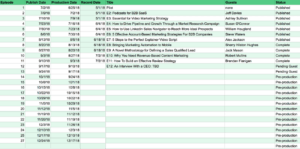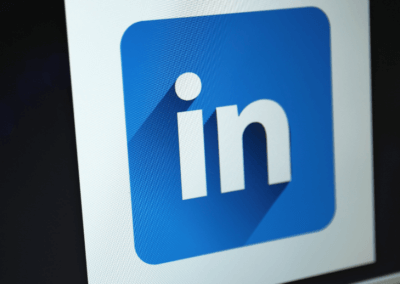Podcasts are one of the hottest new marketing tools of 2018 as B2B marketers look to leverage multimedia content and engage audiences. Businesses across the country from startups to the Fortune 500 use podcasting to reach their target audience where they are — on their mobile devices. For B2B marketers, a recent LinkedIn study finds podcasts to be an effective and underutilized tool, pointing to higher engagement among executives. Analysts discovered that 44% of senior-level decision-makers on LinkedIn (department heads, VPs, owners and C-suite executives) who know what a podcast is are listening to them regularly.

With the excessive use of content marketing, it is becoming increasingly challenging for B2B marketers to rise above the noise and connect with busy decision makers. Consider these five tips to launch your own successful podcast and offer real business value to your buyers:
1. Consider Your Niche
Choosing a podcast niche is difficult. You may feel like all of the good ideas are already taken. You need to be specific and relevant enough to be interesting to your audience while remaining authentic to your own expertise. Ask yourself the following questions — and write down your answers! — to help you hone your niche:
- Who is my audience? Reference your company’s buyer personas, consider when listeners will tune in (on the commute to work? at the gym?), and what challenges they face for which you can provide insight.
- What do I have expertise in? Be honest! Your expertise doesn’t have to be limited to your business’ offering or solution – a host(s) collective industry knowledge, career history, and sphere of influence all make for unique, engaging content.
- What value can I offer? Do your research – Listen to other top industry podcasts to identify what’s already being done. Is there an underserved market you can speak to? An opportunity to provide something new and fresh? Or perhaps you don’t need to reinvent the wheel – consider a popular theme or topic from existing podcasts and run with it. There’s a lot to be said for “brand-better” versus “brand-new”.
TIP: Don’t have detailed buyer personas? Get started with a free template from Hubspot
2. Align the Podcast with Your Brand
Now that you’ve got your niche figured out, the second biggest challenge in charting a course for a successful podcast is crafting the right personality, style, and energy to match that of your company. The best way to align your podcast with your brand is to gather feedback from key stakeholders on the voice and tone of your podcast should have:
- Informative
- Clever
- Experimental
- Conversational
- Casual
- Authoritative
- Energetic
- Innovative
- Funny
- Educational
The key here is to align with your brand identity – whatever that may be – so that your podcasts are perceived as genuine, authentic, and listeners trust what they hear.
3. Create a Style Guide
You’ve done the research and legwork to queue up a pretty great podcast, and are excited to get recording — but a crucial mistake many new podcasters make is forgetting to document these decisions in a centralized place. Inevitably, both internal and external contributors to the podcast will change over time. To ensure clarity and consistency, create a Podcast Style Guide as a reference manual for your show.
4. Develop a Publishing Schedule
We see it often – enthusiastic new podcasters with hopes of publishing weekly or bi-weekly episodes quickly become overwhelmed by the demands of meeting their goal schedule. Picking topics, episode research, scheduling guests, post-production, and promotion for each episode can be enough to make you want to throw in the towel. But with a bit of planning, the episode pre-production and execution tasks become routine and manageable. Whether you use your company’s project management tool or a simple Google Sheet, create a central publishing schedule that both you and your production team have access to.

Podcast Publishing Schedule
TIP: Record and produce episodes in “batches” so that you have a library ready to publish, on schedule.
5. Know the Tech Stack
Most B2B podcasters work out of home or office “studios” rather than a professional sound booth, and with the proper setup, you’d never know the difference. The growing popularity of the podcast medium has brought some fantastic new tools on the market that make it easy to create a polished recording. SmarkLabs recommendations include:
Equipment
Blue Snowball Mic: $49 (you can find additional options here depending on your budget)
Pop filter: $7.99
Sound shield: $64.99
Recording Software
Our recommended alternative to free chat apps like GoToMeeting, Uber, or Skype, is Ringr. Even if you have the perfect room and the best equipment to record, your guests may not have made the same investment. With Ringr, you get the same easy-to-use features of other meeting tools with pre-filtered audio that sounds like you and your guest recorded in the same room.
Pick one place to record and test your audio quality to fine-tune your setup. High ceilings or lots of windows? You’ll need additional sound-dampening shields to reduce echoes. Loud A/C unit humming in the background? Turn off prior to recording or pick a new venue. Take some time to become familiar with your recording software so you’re ready to record and help guests if needed.
Editing Software
The absolute best software you could use to edit your podcasts would be Adobe Audition. Its flexibility supports the editor’s needs by giving you the tools to make your recordings sound their best. It does have a slight learning curve, but it’s well worth it.
Guest Outreach
Make inviting guests easy to manage by setting up an automated outreach campaign. With a tool like Mailshake, you can generate contacts, build relationships, and manage promotion for your podcast all within the same platform.
Repurposing Content
You’re spending a lot of time producing valuable audio content for your audience – don’t let it go to waste. Use a transcription software tool like Rev to amp up the SEO value of your podcast by converting recorded audio into written content for blogs, case studies, and white papers that will drive even more traffic to your site.
6. Call In the Experts
Make no mistake, launching and regularly publishing a podcast is no easy feat. The more your audience grows, the more time you’ll need to spend researching episode topics, engaging guest speakers, and connecting with your listeners.
If you’re having trouble getting started or engagement has plateaued, it’s probably time to bring in some help. Whether you need voice talent, graphic designers, a producer, or a marketing coordinator — ask peers for recommendations and reach out for assistance to keep the show running.




